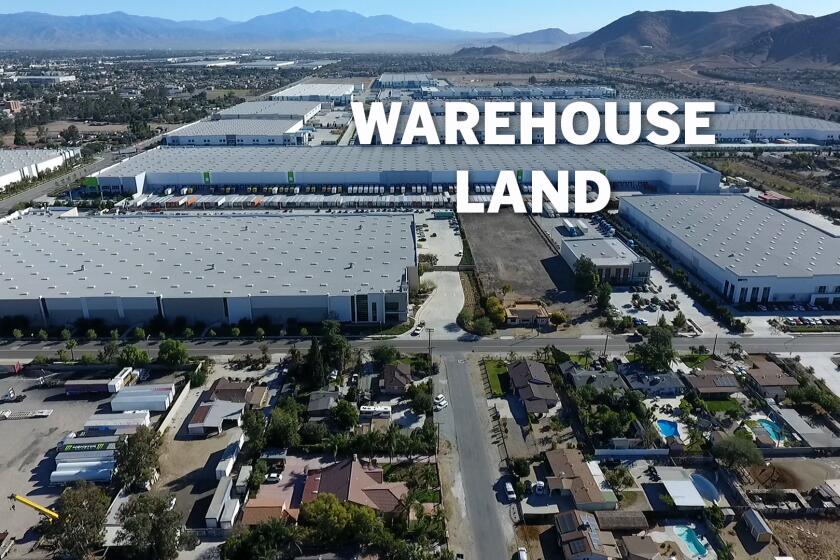Leaked document offers glimpse into how Amazon amasses influence in the Inland Empire

- Share via
In the first two years of the Cheech Marin Center for Chicano Art and Culture’s existence, e-commerce giant Amazon.com was happy to contribute funds to the much-lauded Riverside facility.
But this year, the Cheech hosted an exhibit that included a piece depicting an Amazon warehouse on fire. In an interview, the artist said the piece, titled “Burn Them All Down,” was not a call to arson, but instead a commentary on how public officials were not listening to community concerns about the growing number of warehouses in their Inland Empire neighborhoods.
Amazon saw the comments as being hostile toward the company. The e-commerce firm called it quits on future donations.
“We will not donate to the Cheech,” Amazon officials wrote in a leaked document that outlines the company’s plans for community engagement next year in the Inland Empire. “We will not continue to support organizations that did not result in measurable positive impact in our brand and reputation. Additionally we will not fund organizations that have positioned themselves antagonistically toward our interests.”
The leaked document reveals an extensive public relations strategy by Amazon to donate to community groups, school districts, institutions and charities in the Inland Empire and support sympathetic politicians to burnish the company’s reputation and ensure it is seen as “the most trusted community and business partner in the Southern California area,” according to the plan. The Times independently confirmed the authenticity of the document.
Harry Sentoso, 63, went back to work at Amazon as part of the company’s hiring wave. Two weeks later, he was dead from COVID-19.
The strategy comes as Amazon faces growing opposition to more warehouse-building in the region and unionization efforts at current warehouses.
“It’s not surprising, but it is a little surprising to see it all written out in one memo,” said Sheheryar Kaoosji, executive director of the Warehouse Worker Resource Center, which has been organizing warehouse workers and communities in the Inland Empire for years to advocate for workers’ rights and environmental justice issues.
Despite years of community protest and worker activism over health and safety issues, he said, “Amazon doesn’t take it seriously, calls them perceived issues, and comes up with a plan to divert attention, rather than address any of those things head-on.”
In a statement, Amazon spokesperson Jennifer Flagg did not dispute the provenance of the document, saying Amazon is “proud to be engaged philanthropically in communities across the country.”
The document first publicly surfaced in a post on X from Lorena Gonzalez Fletcher, chief officer of the California Labor Federation, AFL-CIO. In the post, she called it an “interesting read” about how Amazon plans to use charitable donations in communities of color “to fight legislation” on environmental effects of warehouses and labor organizing.
“This post is a blatant mischaracterization of Amazon’s work,” Flagg said in the statement. “Through employee volunteerism or our charitable donations, it is always Amazon’s intention to help support the communities where we work in a way that is most responsive to the needs of that community.”
The plan details efforts to increase community engagement, positive media attention and lawmaker mentions of the company through charitable contributions, alignment with community events and speaking at meetings hosted by Amazon-supported organizations.
One section outlines plans to partner with affinity groups within the company that focus on employees who are veterans, Latino, Black or LGBTQ+ to highlight Amazon’s diversity through participation in local parades and other gatherings.
In California’s Inland Empire, dozens of mega-warehouses for Amazon, UPS and other companies are choking the cities with traffic and air pollution.
The document also highlights efforts to identify and support “influential community voices” such as nonprofits, large charities and local community colleges to “positively influence policymakers and generate third party validators and advocates in the Southern California region.”
It identifies by name a local politician who backed legislation deemed detrimental to the company’s plans: Assemblymember Eloise Gómez Reyes, who supports environmental laws such as Assembly Bill 1000, which would make it harder to build warehouses near schools, homes, day-care centers, hospitals and other sensitive facilities.
In a statement, Reyes said the mention was a “badge of honor.”
“It’s disheartening to see Amazon bypassing direct community engagement and the requested community protections” and instead “prioritizing financial incentives to advance their business objective,” she said in the statement.
The document also lists state and local politicians seen as allies or potential allies. Perris Mayor Marty Vargas is described as “an influential elected leader that we have cultivated through PPE donations to support the region, touring him and his team, and ongoing engagement.” The document also adds that Vargas is influential on the governing body of KSBD, the air freight facility that Amazon operates at San Bernardino International Airport and that has been a site of labor conflict in recent years.
It says there is “opportunity here to work with Assemblymember David Alvarez,” who represents the San Diego district that Lorena Gonzalez Fletcher left to head the California Labor Federation, and who has “been on tours.”
In a statement, Vargas denied that he had a cozy relationship with Amazon. “I vehemently oppose claims that I have been ‘cultivated’ by Amazon through PPE donations and have been courted as an influential governing member of KSBD, which is not in my jurisdiction,” Vargas said. “My relationship with Amazon is no different than any other business within the City of Perris, and in no way am I being used to influence legislation or provide preferential treatment to large scale businesses.”
Alvarez did not immediately respond to requests for comment.
Kaoosji of the Warehouse Worker Resource Center said he saw the mention of the Cheech funding as a clear example of how companies like Amazon view charitable donations: quid pro quos for generating positive sentiment in the community and media.
“There’s a reason they’re doing this, and they’re investing their money in places where they want to see a return,” he said. “They’re businesspeople, that’s what they do, but this is a real mask-off moment for how it works.”
The Riverside Art Museum, the larger institution in which the Cheech resides, said the leaked document was the first time it had heard of Amazon’s reaction to the exhibition. Drew Oberjuerge, the museum’s executive director, said Amazon donated $5,000 to support the Cheech’s inaugural gala in 2022, and then sent another $5,000, unsolicited, this year.
“Neither payment was designated for an exhibition, and the company has not communicated any questions or concerns about an artwork or requested the return of its donations,” she said in a statement.
“We believe in supporting artists and curators who challenge, surprise, delight, annoy and anger,” Oberjuerge said. “It’s through this dialogue we better understand our shared experience.”
More to Read
Inside the business of entertainment
The Wide Shot brings you news, analysis and insights on everything from streaming wars to production — and what it all means for the future.
You may occasionally receive promotional content from the Los Angeles Times.













